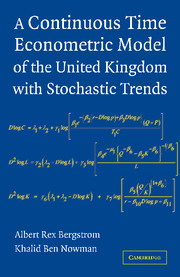Book contents
- Frontmatter
- Contents
- List of Figures and Tables
- Foreword by Peter C. B. Phillips
- Preface
- 1 Introduction to Continuous Time Modelling
- 2 Continuous Time Econometrics with Stochastic Trends
- 3 Model Specification
- 4 Steady State and Stability Analysis
- 5 Empirical Estimation of the Model and Derived Results
- References
- Author Index
- Subject Index
1 - Introduction to Continuous Time Modelling
Published online by Cambridge University Press: 03 March 2010
- Frontmatter
- Contents
- List of Figures and Tables
- Foreword by Peter C. B. Phillips
- Preface
- 1 Introduction to Continuous Time Modelling
- 2 Continuous Time Econometrics with Stochastic Trends
- 3 Model Specification
- 4 Steady State and Stability Analysis
- 5 Empirical Estimation of the Model and Derived Results
- References
- Author Index
- Subject Index
Summary
Introduction
The world's economies and many of its financial markets operate 24 hours a day and the formulation of realistic models to represent the economy and these markets is one of the major challenges facing economists and finance specialists today. Given that the economy is made up of millions of agents making decisions continuously the use of a continuous time model that allows for these interactions to be incorporated will be a more realistic description of the underlying phenomena we are trying to model. In response to this challenge, the econometric estimation of continuous time models in economics and finance has been a major ongoing development over the last 30 years. The major problem faced in such econometric modelling is that we do not have a continuous time record of observations and most economic data are available only at discrete time periods (annually, monthly, quarterly). In finance, data are more frequently available at a higher frequency, for example, daily, hourly and more recently tick-by-tick transactions data. The problem facing an econometric investigator, therefore, is how best to utilize such data in the estimation of an underlying continuous time system so that the fitted model can then be used in economic forecasting, policy analysis and derivative pricing.
In financial markets continuous time models have found widespread applications in financial asset and option pricing since the seminal work of Black and Scholes [1973] and Merton [1973a] and in the general area of continuous time term structure modelling and bond valuation over the last 20 years.
- Type
- Chapter
- Information
- Publisher: Cambridge University PressPrint publication year: 2007



